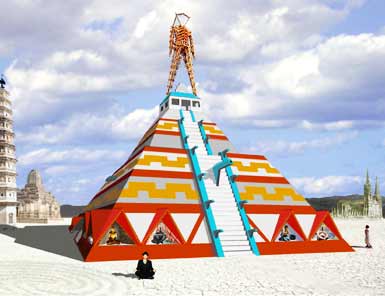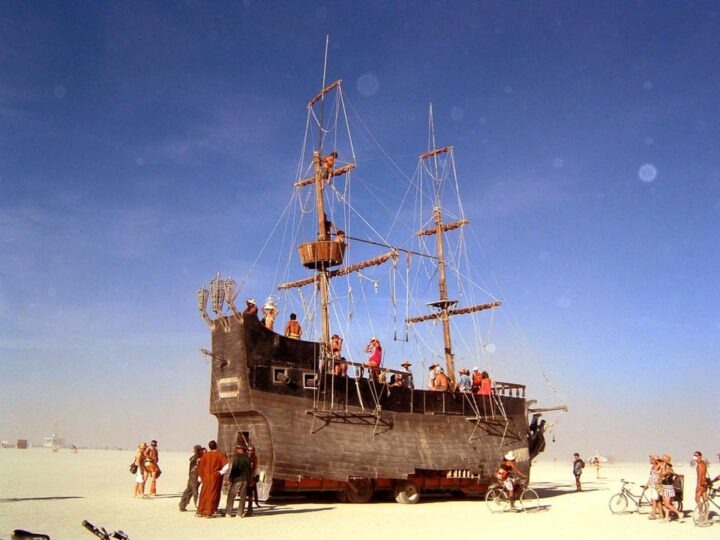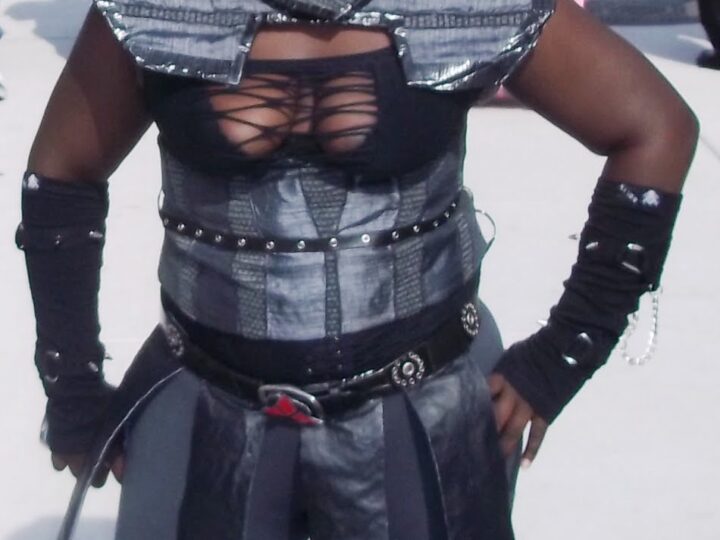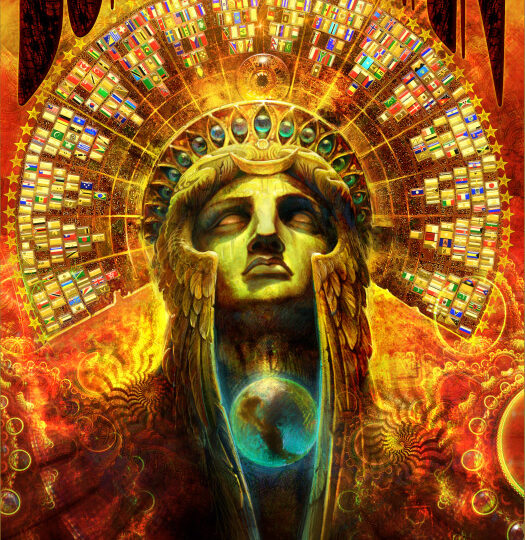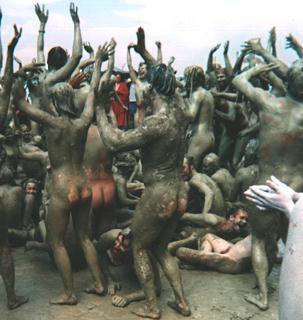
Terminal Beach Party
Many moons ago, a crusty old Chinese anarchist wrote that “we shape clay into
a pot, but it is the emptiness inside that holds whatever we want.” Now I’m
standing on clay, a blank 400 square-mile alkaline slab in northern Nevada know
as the Black Rock Desert. I’m submerged in emptiness. Sixty thousand years ago,
this parched playa was Lake Lahontan; twelve years ago its supremely flat
surface helped some British racing nuts break the world land speed record.
Nothing grows on this blazing, abstract plane. To run a blade of grass between
my toes, I’d have to walk for miles to the mountains that rise in the distance
like the edges of a burnished pot.
So what desires will this emptiness hold? That’s what me and five thousand
freaks and free-thinkers have come to this desolate place to discover. We’re
here for the annual Black Rock Arts Festival — the atavistic avant-garde
Neopagan flame-bake better known as the Burning Man.
And there’s the Man himself: a forty-foot-tall timber giant, with a body like
an electrical tower and a head like a Japanese lantern. The Man is utterly
still in the chaos that swirls below him, as hordes of Left Coast anarchists,
acidheads, gun nuts, ravers and technopagans jerry-build an art brut
nomad town across the playa: a turbulent array of art cars, RVs, camouflage
nets, fake palm trees, generators, flags, fires and candelabrums that evolves
like some Road Warrior knock-off of SimCity. And the Man watches over it all,
stoically resigned for Sunday night, when flame-throwers will spit like dragons
and he will burn, baby, burn.
Forget mega-malls and the imploding data-hive of the Internet: here is
postmodern space. As one Hawaiian-shirt-clad hipster calls out, careening by on
a bike festooned with teddy bears: “You’re there! You’re nowhere!” Distances
are deceptive on the playa, where a shifting latticework of tire tracks emerges
like those webs laboratory spiders weave on speed. At night, getting lost is a
serious issue, as your vectors depend on little more than a pirate radio tower
and the Man’s cool blue neon tubing, an empty sigil that guides but refuses to
signify. And who really knows their stars anymore?
This sprawling zone does have a center, which this year features a boulevard
of interactive theme camps. At the Portland Cacophony Society’s Bigfoot Plaza,
a song and a dance (literally) wins you a pair of thrift store shoes; at the
Tiki Camp, Cap’n Kahunadoggie offers up occasional blender beverages from the
heart of exotica. Nearby, curling incense smoke anoints a tyke-high carven
caveman, only one of many swap-meet idols (a plastic camel, a monstrous Paisley
lizard, a six-foot-high fast-food wiener dog head) that helped generate Burning
Man’s curiously Neolithic energy.
***
After helping to set up the Spiral Oasis camp with a crew of media bohemians
I only vaguely knew, I marveled at the stilt walkers, the Goth fire swallowers,
the Renaissance Faire dude playing a flute in a storm; I dodged the 3-wheeled
banana bike, the shark car, the Bug Truck with its store of frozen insects; I
thrilled to the Church of Warm Noise, the Harpo Marx Memorial Croquet Society,
and the Flaming ManBurning Man’s queer brother, his limp-wristed wooden
outstretched hand flipped with perfect panache. Even the local sheriffs zooming
by on their Mad Max mobiles were subsumed in this surreal experiment.
I found myself going native as well, and though I basically restricted my
pharmocological diet to alcohol and cigars, I kept bumping into deja vus,
flashbacks, and dreamscapes. Still my inner grad student could not help but
call attention to things like “the modes of cultural production and
consumption.” Burning Man is a guerilla war against alienated spectacle and the
commodification of the collective imagination. Sure, someone was selling
Burning Man t-shirts and videos, media vampires like CNN and Hotwired and me
were feeding, and there were enough cameras there to insure the event’s virtual
life through a thousand slide shows and Web sites. But the folks that had
poured months of sweat, money and thrift store excavations into their creations
were not mugging for camerasthe fruit of their labor was meant to be eaten to
the core. This was George Bataille’s festival of excess, a potlach of useless
gift-giving and random kindnesses, a prime example of what Hakim Bey, the great
poet of such temporary autonomous zones, calls “immediatism”: creative play
that subverts its own tendency to stand between us as Art. Like the Pyrodesiac
fire dancer from Vancouver who would perform until a crowd spontaneously formed
about her, at which point she would run away.
Now that the Burning Man is no longer so esoteric (the event’s attendance has
more than doubled every year), many folks come just to gape, like the male
shutterbugs that clustered around two scantily-clad babes gyrating on top of an
old fire department vehicle. Though anticipating 10,000 folks next year,
Burning Man founder Larry Harvey remains optimistic: “The idea of radical
participation is so damn infectious, it just engulfs you.” True, much of this
participation would seem dull and naive in the city, evidence for the British
journalist Sheila Hayman’s onsite observation that Americans possess a
seemingly boundless capacity for infantilism. But out in this Pleistocene
petri dish, the Burning Man is powerful living theater, powerful despite its
“crudity” in exactly the same way that half-nude folks freely weaving about a
bonfire are erotic regardless of their bodyshapes.
***
Northwestern Nevada is no more a vacuum than the New World was in 1492, and
interacting with gawking locals was part of the fun: dudes in dune buggies with
Confederate flags, grinning cops, rosey-faced oldsters with bemused grins and
plastic cups of Bud. I asked one off-roading gentlemen outfitted in full
camouflage what he thought of the scene. He crossed his arms, studiously
avoided my gaze, and shrugged. “Different kind of weekend,” he drawled.
But the rugged, gun-toting individualists that pepper these hills are not so
out of place at Burning Man as one might expect. Just ask John Law, the heavy
honcho responsible for the Man’s neon glow. For him, creating genuine
connections with officials and residents of nearby towns Gerlach and Empire is
part of the beauty of the Man. That’s why the Empire Girls High School
Basketball Team was here, selling ice to raise money for new uniforms. “I’m an
atheist, and this is God’s country,” Law says. “The people are astoundingly
tolerant of the weirdness going on here.”
One obvious point of commonality is the fact that, in the grand tradition of
American anti-authoritarianism, a number of Burning Man folks pack heat. “We
got guys here that can hit a moving target with a bolt-action at 100 yards,”
says Law. “That’s another reason the local people didn’t fuck with us and
gradually grew to respect us.” Though all the Chinese SKs must be empty of ammo
in Burning Man town, NRA fans had their offsite choice between shotgun skeet
golf and a drive-by shooting range, which featured the spectacle of various
B-movie tough guys and nihilist hicks unloading lead into large stuffed
animals: “Die, Barney, dieeee!!!”
Though Law’s courteous manner and massive moustache make him look like a rural
ranch hand, he’s a city dweller who was raising Cain with the San Francisco
Suicide Club long before Larry Harvey torched the first Man at a solstice beach
fete in 1986. A hardcore anarchist group that infiltrated the Moonies and the
American Nazi Party just to see where their heads were at, the Club eventually
mutated into the similarly motivated Cacophony Society. When Harvey’s annual
burn ran afoul with the police, Law suggested that they drag the event to the
playa, a place first introduced to him by a redneck monster-truck fan.
At first, the folks in Gerlach thought the visitors were Satanists, and when
the cops came, “they were ready for a war.” But as part of their paradoxical
quest to “keep the playa safe for anarchy,” Law, and the all-volunteer Black
Rock Rangers security force led by Danger Ranger and Vanessa Kuemmerle, have
since formed close contacts with the various cops that have jurisdiction over
this federal property. When a woman suffered a neck injury in a nighttime bike
accident, the cops and Rangers provided one of the weekend’s more Blade Runner
moments by successfully organizing a Medevac rescue (which, in an
anti-authoritarian or at least a drunken move, the woman refused). “It would
have been a cluster fuck if there hadn’t been coordination,” Law said.
“The law enforcement has been unbelievably wonderful,” Kuemmerle said,
pointing out that not one arrest was made on the playa. “I’m as counterculture
as anybody, but it felt good to have them on our side.” Next year, the sheriffs
plan to have their own theme camp and have even agreed to enter one participant
in the fashion show.
***
As a Sani-Hut employee prepared to empty one of the portable toilets that
peppered the playa, a severely urgent hippy chick attempted to beat him to the
pot. “Hey there,” he warned, “don’t give me any shit.” Later I asked one of his
co-workers, a chunky high school kid from Reno, what he thought of the
gathering. “Everyone seems really relaxed. It doesn’t matter what your wearing
or anything.” He shrugged. “Nothing matters.”
Nothing matters. My man’s terse but altogether dead-on formulation illuminated
the fruitful meaninglessness that powers this vagrant, belated carnival. At
Burning Man, it’s almost a cliche that all interpretations of the event are
bullshit, that “meaning” is dogmeat in the face of experiment and experience.
While this discursive dodge allows sacred forces to emerge that might otherwise
curdle in a New Age froth, it nonetheless indicates a certain last-ditch
immobility of thought, a slap-happy irony more apocalyptic than any festooned
dune buggy or flaming metal sculpture. As the T-shirt says, Christ is
cominglook busy.
Just line up the Burning Man next to the Rainbow Gathering, the decades-old
hippy nomad village that plants itself in a national forest every summer.
Drawing from essentially the same core of disaffected middle-class whites, the
Gathering similarly emphasizes spontaneous play, wilderness survival and a lack
of concession stands. But while the Gathering imagines itself as an earnest,
Luddite eco-utopian tribal reunion, the Burning Man is defined by speed, urban
detritus, slumming media professionals, and the chaos of technology. As a Pagan
dressed only in a chainmail loincloth told me, “I love the Gathering, but the
Burning Man is more clued in with where our culture is at. Now is not the time
to listen to Natives and the trees.”
Which is to say that now is the time to project lasers, blast jungle beats,
and blow shit up. As an otherwise lame Burning Man zine pointed out, the
earth-mother stuff doesn’t cut it in this desert voidthe more
techno-industrial the aesthetic, the more it works. The tweaked video, the
cellular modems spitting bits to a router back in Gerlach, the fiber optic
special effectsout here they speak the truth of our condition far more than
any drum circle.
“This is like a virtual community without electronics,” said Nick West, an
ex-Bay Area media artist and four-time Burning Man attendee who now teaches at
NYU and runs the interactive Yorb show on New York public access. “It’s a blank
slate upon which we write culture. That’s cyberspace at its most utopian.” But
West also sees the resignation that motivates this quest for blank slates.
“It’s a shame that people have given up the social will to change the physical
space in our real communities, so that we have to come out here in the middle
of the desert to do it. That makes me scared about cyberspace.”
Late one night, my friend Wef had a kind of vision as he dodged the speeding
cars on the way to the rave camp a mile south. The playa became the earth, and
all our lights and art and noise became our civilization careening out of
control. “Here we’ve set up a situation where technology and distraction are
standing out distinctly as a dysfunctional thing.” This was made perfectly
clear to him when he came upon a solitary man watching a Klingon battle scene
projected onto the side of a RV at ear-splitting volume. “Shields down to
twenty percent!”
But if Burning Man expressed a white-hot culture with its shields down, it
also showed how much love lay amid the ruins. The playa created space for the
chaotic resolution of the same contradictory impulses that are otherwise
rending the world. As Wef put it, “The technological imbalance was in balance.
Nature was not fazed. The desert was not going to be hurt by it. Like the
universal heart which can forgive or transcend all petty crimes, the desert
dwarfed all our manic displays of technology and pyromania with its display of
wind and hailstorms and heat.”
The first of these fantastic storms gathered to the south late Saturday
afternoon, as I danced to DJ Spooky’s dense, angular mix at the booming Wicked
camp and watched a train move slow and lonesome along the base of the
cloud-darkened mountains. The second one hit later that night, ruining the
plans of countless performance artists: the denizens of Toy Land blew up their
skewered teddy bears and crucified childhood fetishes in a maniacal frenzy,
while green lasers interlaced with lightning above and the amazing San
Francisco band Beyond Race was galvanized into a blistering mid-70s funkfest.
When the squall hit, I vainly sought shelter in McSatan’s Beastro (“No tofu
here”), chewing on a wet stogie until I just gave myself to the windwhip and
rain.
But even that blast could not beat Sunday afternoon’s, when everyone at Spiral
Oasis felt their hair stand on end and the electrical charge in the event tent
created audible static. We foolishly clutched our tent poles in the lightning
storm, grinning into the ferocious winds that rained hail and blew away
everything not weighted down. Afterwards, as we skated along the slick clinging
mud, a perfect double rainbow unfurled to the east as the storm crafted a
forty-thousand-foot mushroom cloud in its wake. Nature was definitely in the
house.
***
On Sunday afternoon, following a dull fashion show enlivened only by a
handful of desert Priscillas, an impassioned woman took the stage and tried to
organize the fire-hungry mob into the proper mood for the Burning of the Man.
“There’s a time for anarchy, and a time for focus,” she pleaded. But however
much she went on about “burning up karma” and rising Phoenix-like from the
Man’s ashes, it was clear that what lay ahead was more spectacle than ritual.
Not that the devotional parallels weren’t coming fast and thick as I took in
the masks and bodypaint and flags sewn with sigils. The clangy dusty ragged
procession that led to the Man differed little from the zillion clangy dusty
ragged processions that have marched through the ages towards a mystery waiting
to burn. If you remember that ritual is at least as much performance as
narrative, then we’re not so far from the Celtic sacrifices portrayed in the
mid-70s pagan flick TheWicker Man . Closer still are the old
Mediterranean mystery cults of Mithras, Isis and Eleusisprimal theatrical
experiences that overlaid ancient fertility rites and appealed to, as Burning
Man participating Darryl Van Rhey pointed out in Gnosis magazine, “a
sophisticated and self-conscious” urban milieu.
As Larry Harvey told me, “We live in a postmodern world. Everything that’s
every happened is happening now, yet nothing is terribly compelling. On the one
hand you have immense freedom; on the other hand you have this intense anomie.
You can communicate with anybody on the world in the Internet, but so what?
Here we’ve resorted to a kind of primal psychology, a level of experience that
lies at the heart of all ritualprimordial, pre-verbal, prehistoric. The
genesis of that feeling is standing around a camp fire. You have to reach back
that far to find something that’s going to bring people together. And we’re
going at it in a very American, very pragmatic way. We’re doing it because it
works. There’s nothing supernatural about it.”
Supernatural or not, I missed the Exploding Man and the fireworks-stuffed
clowns from the year before. After a weird little booming jet car zoomed around
the crowd with a red hot sternum-rattling engine a few times, the event
reverted to a fireworks show where you had to dodge the fireworks. Best was the
voice-of-authority bullhorn behind us: “Your cooperation is no longer
required.” “Please move on. There’s nothing to see here. The man will burn
without you.” The Man did indeed burn, and so many cameras went off then it
must have looked like St. Elmo’s fire to all the bow-hunters and hermits
watching from the hills. He was yanked to the ground, spewing clouds of
choking, poisonous smoke. If we were invoking gods, they were desperate and
toxic ones.
More impressive was the subsequent torching of Pepe Ozan’s fire lingam, a 30
foot tall clay sculpture that looked like a pornographic Yes album cover. We
sat down for some decent occult performance art, and soon a couple of
magnificently horned ringwraiths lit the fire and the lingam started spewing
iridescent flame. Then this midget dressed in dog collar, leather pants and a
bullet belt stumbled out of the crowd and plopped right down in my ladyfriend’s
lap. As bloody hell-wenches dragged themselves through the dust before us, this
Lilliputian fetishist scooted down and started clawing at her thighs before
passing out altogether.
After that, the band Sharkbait’s DIY industrial schtick (tossing drum sticks
and pieces of metal to the crowd) just couldn’t compare. I left the scene with
the unchanged heart that indicates poor ritual or less than memorable art.
But I returned to a camp I’d grown to love, where people I’d probably feel
vaguely anxious around amidst the wine and weed at your average redwood deck
party were hanging about in various states of undress, painted with mud, happy.
Keith Bontrager, a famous Santa Cruz mountain bike manufacturer, was tossing
thousands of dollars worth of tweaked magnesium frames onto the fire. Tomorrow
their ashes would add to the cigarette butts and trash it would take a handful
of volunteers nearly a week to clean off the playa. But tonight the metal
burned with an implacable white light, like the absolute luminescence the
Tibetan yogis say awaits us at death, or a snapshot of starlight, or the first
stages of a total meltdown.
Originally appeared in The Village Voice

